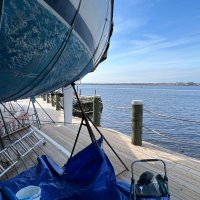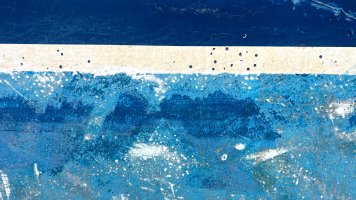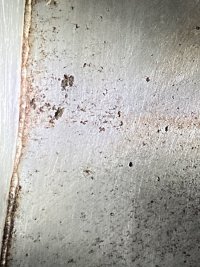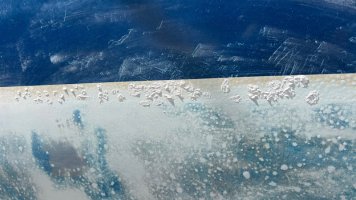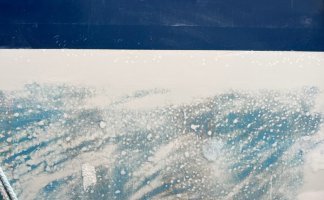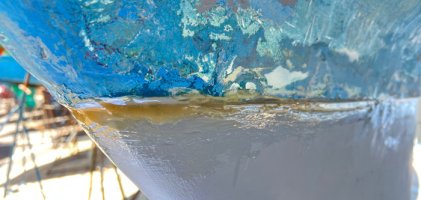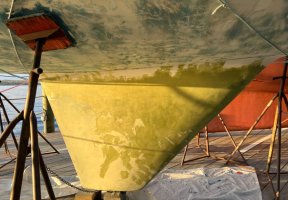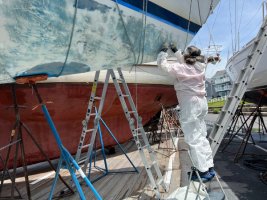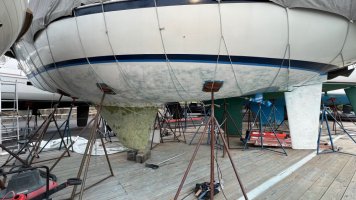Prairie Schooner
Jeff & Donna, E35-3 purchased 7/21
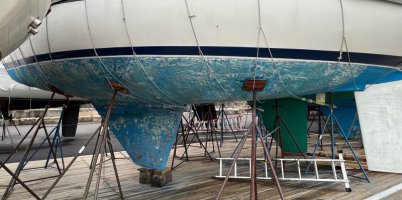
One of this year’s projects is stripping the bottom to the original surface (gel coat?). I’m scraping off what must be at least two decades of bottom paint in most places. This photo shows the tools I’m finding most useful.
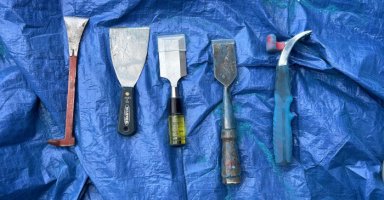
There isn’t a Master Thread on bottom painting or repair as of this writing. This thread seemed to have a wider variety of perspectives so I thought it would be a good place to leave some breadcrumbs. These are the posts I’ve found helpful:
Bottom paint prep
Will talk to them Monday , but yard has done a lot of sanding of hull to prep for bottom paint which I wasn’t really expecting ( first time I’ve done this as the boat is new to me about 2 1/2 years ) . They showed me a few larger blisters and peeling paint they recommend for repair which I...
Barrier coat over antifouling!?!?
Hi everyone. Work is progressing on rehabbing our E34-2. One of the projects on my list is redoing the bottom since the antifouling was failing (large chips/flaking). Im using Aqua Strip to do the majority of the job and then plan on sanding the rest to get as fair a surface as I can. But I’m...
Bottom Job - Revisited
I will be at the yard this weekend to hopefully complete removing the motor from the boat, pull the winches for a service, and just generally clean/organize my work space as I will be starting some of my other projects once the motor is gone. One of my ancillary missions is to visit with the...
- https://www.interlux.com/en/us/paint-guide/BW057-how-to-fully-repaint-bare-grp-frp
Drying the hull
Over the past year I've been doing a major blister repair job for which I've sought advice under different entries in this forum. I had always heard that one way to deal with blister is to simply dry out the hull. Well, in the process of filling our ground-out blisters we discovered three that...
Bottom paint failure
Boat - 1983 E30+ in the middle Chesapeake. Timeline: Feb 2014, boat purchased, the broker says "Fresh coat of bottom paint". Doesn't specify what type, but appears some ablative type. March 2016, old dock hand at the junk marina we're at says "Oh, yeah, just sand up what's on there a little...
E26-2 - Haul-out and Bottom Paint
Sanding, thru-hull removal, rudder repair, fiberglass work, and painting. All the fun I had while hauled out. I bought Sigla bottom-unseen. The previous owner had a rough idea of when it had been out of the water last, but not many details...
barrier coat issues
The boat was soda blasted last fall; the yard did 3 coats of barrier and VC-17 bottom paint. Lifted the boat off the cradle to place on jack stands to finish the barrier/bottom paint - the straps "peeled" the barrier/bottom paint off in chunks! Not good. Not enough drying time? Question...
Barrier coat over antifouling!?!?
Hi everyone. Work is progressing on rehabbing our E34-2. One of the projects on my list is redoing the bottom since the antifouling was failing (large chips/flaking). Im using Aqua Strip to do the majority of the job and then plan on sanding the rest to get as fair a surface as I can. But I’m...
To barrier coat or not to barrier coat?
I am asking for opinions on whether or not it is a bad idea to barrier coat just select areas of the hull before bottom paint. I have repaired a handful of large blisters and don't want to leave the areas around them that are sanded down to gel coat vulnerable to further blistering. However, I...
Bottom paint on Blister repairs
I pulled my e27 for some early spring work. After 22 months in the water the bottom was generally in excellent shape. I was dumbfounded actually by the good condition. However, in a few places where I made blister repairs in the past, the WM ablative bottom paint wore off down to the epoxy...
How frequently to paint the bottom, if at all?
Saw a post about bottom paint on another forum - sorry for the wandering eye ;) - and thought I'd ask a question here. We keep our 35-3 in the water year-round. The bottom was last painted in 2020 or 2021 by the previous owner. Was planning to get it repainted next spring, but my diver seems...
Rule of thumb for cloth, thickened epoxy or just fairing in abundant blister repairs?
We are in the midst of a major hull repair job after finding abundant blisters under the bottom paint on our new-to-us 1982 E38. I posted about this in the fall before we removed the bottom paint. It didn't look quite so bad then. Less than a dozen blisters reached the laminate, and none seemed...
Blistering - dealbreaker or nah?
I’m looking at a 1980 38 footer for sale. It’s in generally good shape, but there are fairly large blisters on the hull. I’ve read a lot of conflicting opinions on if blisters ever actually a potential structural danger, or merely cosmetic (meaning they don’t penetrate the woven fibers because...
Need best advice on blister repair
Our 1984 E30+ has been babied for most of her life, and I have kept her in great shape since acquiring her from a discerning owner 11 years ago. I have hauled her every two years, sometimes a bit more often, to check hull, renew bottom paint, etc. She has always had some blisters at the...
Fairing keel-hull joint
Greetings from Panama, On our Ericson 38, we made some miles and ended up hauling out in Panama, in the middle of a jungle. This is a French operated DIY yard. The long list of our projects include installing a new shaft seal, eliminating rudder play and a new bottom paint. Unfortunately, when...
Keel smile
Hi everyone, I'm trying to become an Ericson 32-3 owner, I mean I have an accepted offer on a 1985 model but there is an issue with the forward 1/4 of the joint between the ballast keel and the boss/sump it meets with. The joint has a crack from the leading edge back to the first double set of...
After reading all this, and more, the plan is to sand the rest down, patch any dings/scratches with filled epoxy, fair the keel, apply barrier coat (2-4 coats), then bottom paint. I used Total Boat Total Protect over the transducer and strut work and that seems to have held up well, so that’s what we’ll use for barrier coat. For bottom paint we picked up Micron CSC, black. We’re doing the rudder in white again.
Ambience.
